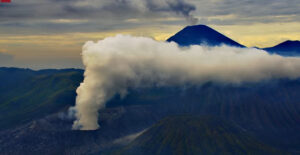Pluto is weird. Before the scientific community decided it wasn’t a planet, the tiny, distant lump of ice commanded a certain mystique.
Named after the Roman god of the underworld, one lap around the sun takes almost 250 years. The average surface temperature is -233°C. The list goes on.
Now, you can add ice volcanoes the size of Himalayan peaks to it.
NASA finds Pluto’s massive ice volcanoes
In July 2015, NASA’s New Horizons mission performed a flyby of the icy celestial outpost and its five moons. It seems that NASA sometimes takes as long to release information as it does for its probes to reach distant parts of our galaxy. But the evidence it found has rewritten our understanding of the dwarf planet.

NASA’s New Horizons spacecraft, pre-launch in 2005. Photo: PD-USGov-NASA via Wiki Commons
Photos showed an unusually bumpy region on Pluto’s surface. According to researchers, it doesn’t look like any other part of the small world — or anything else nearby.
The findings were published yesterday in the journal Nature Communications. It describes a region near a 1,000km-wide ice sheet that bristles with volcanic domes.

The Wright Mons area, near the 1,000km Sputnik Planitia ice sheet. Photo: NASA/Johns Hopkins University Applied Physics Laboratory/Southwest Research Institute via Wiki Commons
Two of the most prominent features are called Wright Mons and Piccard Mons.
Wright Mons is 4,000-5,000m tall and spans a massive 150km. Nearby, Piccard Mons soars 7,000m high (about the height of Baruntse) and sprawls across 225km. (Piccard Mons is not named after Star Trek‘s Jean-Luc Picard, but rather, 20th-century balloonist Auguste Piccard.)
Researchers think that Wright Mons has about the same volume as Mauna Loa volcano in Hawaii, U.S. — one of the biggest volcanoes on Earth.
Ice volcanoes erupt with bizarre fluid
What happens when Pluto’s volcanoes erupt, though, is in some ways precisely the opposite of what happens when terrestrial volcanoes do.
Instead of magma, water surges toward the surface. Then it freezes as soon as it hits the blisteringly cold air.

Pluto’s volcanic region is unlike any other area on the dwarf planet. Photo: NASA/JHU Applied Physics Laboratory/SRI/Isaac Herrera/Kelsi Singer
It sounds like you’d want to bring a kit for mixed terrain if you were going to climb a Plutonian ice volcano. The formations, called cryovolcanos, have been observed elsewhere in our solar system. They can transfer any material from the subsurface to the surface to create new terrain.
They can even form on Earth (albeit at a smaller scale).

A small ice volcano on Lake Michigan. Photo: John Winkelman via Wiki Commons.
The process would look distinctly weird to watch. Pluto’s sky is blue, but its snow would appear red if you stood on the surface. And the study’s author said the fluid that comes out of the volcanoes might only be tangentially familiar.
“The icy material was probably more of a slushy mix of ice and water or more like toothpaste while it flowed out of a volcanic vent onto the surface of Pluto,” said Kelsi Singer, a senior research scientist at the Southwest Research Institute in Boulder, Colo. “It is so cold on the surface of Pluto that liquid water cannot remain there for long. In some cases, the flow of material formed the massive domes that we see, as well as the lumpy terrain found everywhere in this region.”
Life remains unlikely on this alien world
The findings indicate that, unlike previously thought, Pluto has at least a moderately hot interior. Previous research confirmed that it once contained an ocean some distance below its surface. The new evidence of internal heating indicates that it may still exist.
Life resembling anything comprehensible to us is still an unlikely prospect on this strange world. Nutrients figure to be sparse at best, and the heat source may only generate warmth episodically.
But Singer didn’t rule out the idea of looking for it. And while her team would be looking for aliens in every sense of the word, they’d be using technology that’s highly familiar on terra firma.
“If we did send a future mission, we could use ice-penetrating radar to peer directly into Pluto and possibly even see what the volcanic plumbing looks like,” Singer said.






